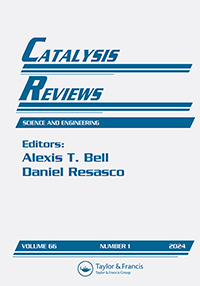深度加氢脱硫催化研究进展
IF 9.3
2区 化学
Q1 CHEMISTRY, PHYSICAL
引用次数: 192
摘要
为了生产清洁燃烧的燃料,加氢脱硫在石油加工中的重要性日益增加,导致了对加氢脱硫化学和工程的大量研究。早期的工作大多集中在用物理方法表征催化剂;噻吩等具有较高反应活性化合物的低压反应研究工艺开发;或在氧化铝上负载的CoMo、NiMo或NiW催化剂上,通常掺杂氟或磷。几乎所有的评论都集中在氧化铝负载的CoMo、NiMo和NiW硫化物催化剂的加氢处理上。即使是不局限于上述催化系统的评论基本上也涉及像噻吩这样的简单化合物的研究。本文章由计算机程序翻译,如有差异,请以英文原文为准。
A review of deep hydrodesulfurization catalysis
Introduction The increasing importance of hydrodesulfurization (HDS) in petroleum processing in order to produce clean-burning fuels has led to a surge of research on the chemistry and engineering of HDS. Most of the earlier works are focused on catalyst characterization by physical methods; on low-pressure reaction studies of compounds like thiophene having relatively high reactivities; on process development; or on CoMo, NiMo, or NiW catalysts supported on alumina, often doped by fluorine or phosphorus. Almost all the reviews have concentrated on alumina-supported CoMo, NiMo, and NiW sulfide catalysts for hydrotreating. Even reviews that are not limited to the above catalytic systems essentially deal with studies of simple compounds like thiophene.
求助全文
通过发布文献求助,成功后即可免费获取论文全文。
去求助
来源期刊
CiteScore
22.30
自引率
2.80%
发文量
29
期刊介绍:
Catalysis Reviews is dedicated to fostering interdisciplinary perspectives in catalytic science and engineering, catering to a global audience of industrial and academic researchers. This journal serves as a bridge between the realms of heterogeneous, homogeneous, and bio-catalysis, providing a crucial and critical evaluation of the current state of catalytic science and engineering. Published topics encompass advances in technology and theory, engineering and chemical aspects of catalytic reactions, reactor design, computer models, analytical tools, and statistical evaluations.

 求助内容:
求助内容: 应助结果提醒方式:
应助结果提醒方式:


